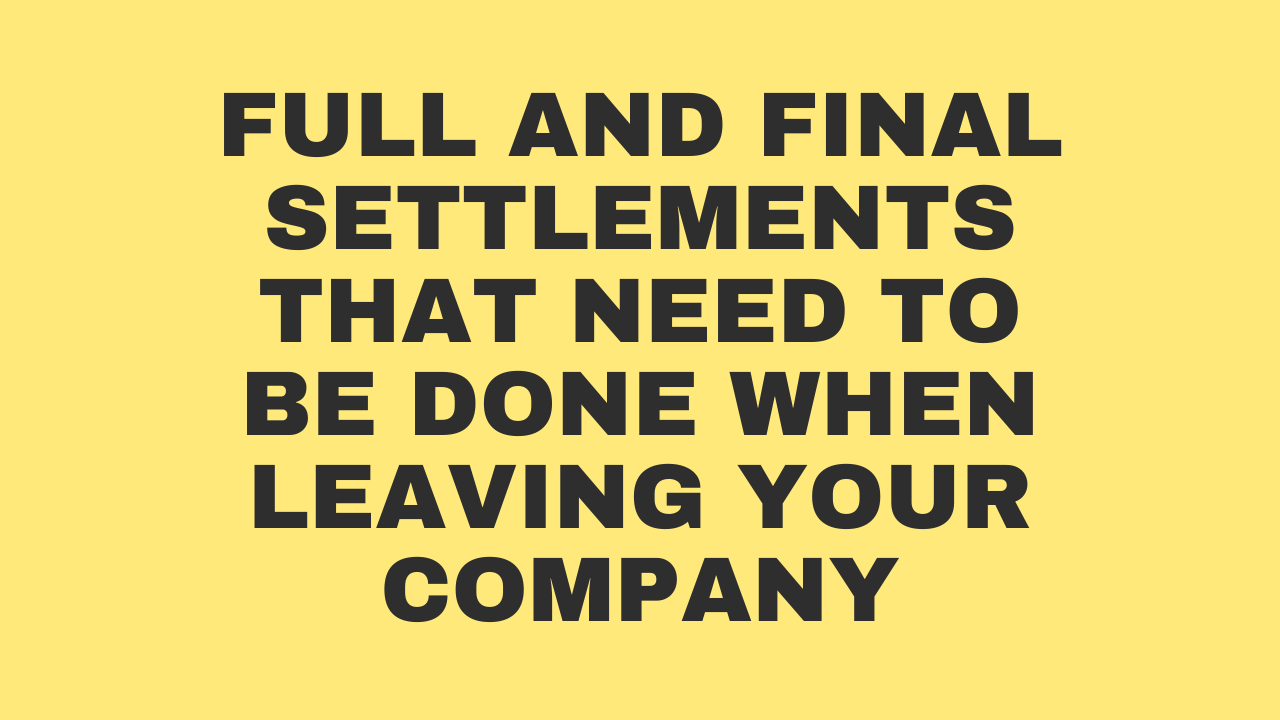When leaving a company, it is essential to ensure that all financial matters and obligations are properly settled. This process, known as a full and final settlement, involves reconciling any outstanding payments, dues, and benefits owed to the employee by the employer. It is crucial for both parties to complete this settlement accurately and in a timely manner to avoid any legal or financial complications. In this guide, we will outline the key aspects of a full and final settlement that need to be addressed when leaving your company. By understanding the process and following the necessary steps, you can ensure a smooth transition and safeguard your financial interests.
Understanding Full and Final Settlement:
When an employee decides to leave a company, a full and final settlement is the process of resolving all financial matters and obligations between the employer and the employee. It ensures that both parties are clear of any outstanding dues, payments, or benefits owed to the employee before their departure.
The full and final settlement is a crucial step to ensure a smooth transition and to safeguard the financial interests of both the employer and the employee. It helps in maintaining a good professional relationship and avoids any legal or financial complications in the future.
Salary and Dues:
One of the crucial aspects of a full and final settlement when leaving a company is the settlement of salary and dues. It involves ensuring that all outstanding payments related to the employee’s compensation are properly accounted for and settled. Here’s what you need to consider:
- Pending Salary Payments:
Determine if there are any pending salary payments for the current month or previous months that are due to you. This includes regular salary as well as any arrears or adjustments. - Notice Period Salary:
Calculate and verify if you are entitled to receive salary for the notice period as per your employment agreement or company policies. This is particularly relevant if you have served the notice period or if the company has relieved you of the notice period early. - Unpaid Allowances, Bonuses, or Incentives:
Check if there are any outstanding allowances, such as travel or housing allowances, that are due to be paid.
Inquire about any pending bonuses or incentives that you may be eligible for based on your performance or company policies. - Final Settlement Calculation:
Collaborate with the company’s HR or finance department to ensure that the final settlement calculation is accurate. This includes verifying deductions such as taxes, provident fund contributions, and any other applicable deductions. - Gratuity or Retirement Benefits:
If you are eligible for gratuity or other retirement benefits as per company policies or local regulations, ensure that the calculations are done correctly and that the payment is included in the full and final settlement. - Salary Slips and Documentation:
Collect copies of your salary slips and other relevant documents as proof of your salary payments and allowances. These can be useful for reference and verification during the settlement process. - Timelines for Payment:
Inquire about the expected timeline for the payment of salary and dues. Understand the process that the company follows for disbursing these payments and ensure that it aligns with the agreed-upon terms.
Leave Encashment and Benefits:
Leave encashment and benefits are important components of a full and final settlement when leaving a company. They involve the settlement of accrued leaves and the payment of other employee benefits that you may be entitled to. Here’s what you need to consider:
- Accrued Leave Balance:
Determine the number of leaves you have accrued but not utilized during your employment. This includes annual leave, sick leave, and any other types of leave as per company policies. - Leave Encashment Policy:
Review the company’s leave encashment policy to understand the rules and eligibility criteria for encashing accrued leaves. This policy may vary from company to company. - Calculation of Leave Encashment:
Calculate the value of your accrued leave based on your salary and the company’s policies. This calculation is usually done by multiplying the number of unused leaves by your daily wage or by referring to a pre-determined formula. - Other Employee Benefits:
Identify any other employee benefits that you may be entitled to upon leaving the company. This could include provident fund contributions, gratuity, health insurance, or any other benefits specified in your employment agreement or company policies. - Verification of Benefits:
Collaborate with the HR department or relevant personnel to verify the calculation of leave encashment and other employee benefits. Ensure that the calculations are accurate and aligned with the company’s policies and applicable laws. - Taxation on Leave Encashment:
Understand the tax implications of leave encashment and other benefits. In some jurisdictions, leave encashment may be subject to tax deductions or may be treated as taxable income. Consult with a tax professional or refer to tax regulations to understand the tax implications in your specific case. - Timing of Payments:
Inquire about the timeline for the payment of leave encashment and other benefits. Understand the process that the company follows for disbursing these payments and ensure that it aligns with the agreed-upon terms. - Documentation:
Maintain copies of relevant documents, such as leave balance statements, leave encashment calculations, and any other supporting documents related to employee benefits. These documents can serve as proof and reference during the settlement process.
Reimbursements and Expenses:
As part of the full and final settlement when leaving a company, it is important to address any outstanding reimbursements for business expenses incurred during your employment. Here’s what you need to consider regarding reimbursements and expenses:
- Business Expense Claims:
Review any pending business expense claims that have not been reimbursed by the company. This may include expenses such as travel, accommodation, meals, or other authorized expenses incurred for business purposes. - Submission of Expense Reports:
Compile all the necessary supporting documents, such as receipts or invoices, related to your business expenses. Ensure that you have maintained proper records and that the expenses are eligible for reimbursement according to the company’s expense policy. - Expense Claim Deadline:
Check if there is a specific deadline for submitting expense claims after which reimbursement requests may not be entertained. Make sure you submit your claims within the stipulated time frame to ensure timely processing. - Verification Process:
Collaborate with the appropriate department, such as finance or HR, to verify and validate your expense claims. They may review the submitted documentation to ensure compliance with company policies and reimbursement guidelines. - Timelines for Reimbursement:
Inquire about the expected timeline for the reimbursement of your business expenses. Understand the process that the company follows for reviewing and approving expense claims, and ensure that it aligns with the agreed-upon terms. - Method of Reimbursement:
Discuss the method of reimbursement with the company, such as direct bank transfer or issuing a reimbursement check. Provide the necessary banking details or address to facilitate the reimbursement process. - Documentation:
Keep copies of all expense reports, receipts, and any other relevant documents related to your business expenses. These documents will serve as evidence and support during the settlement process and can be used for future reference, if needed. - Communication and Follow-up:
Maintain open communication with the finance or HR department regarding the status of your expense claims and the reimbursement process. Follow up if there are any delays or issues in receiving the reimbursements.
FAQs:
- Will I receive my pending salary as part of the full and final settlement?
a. Yes, any pending salary payments, including salary for the notice period, should be included in the full and final settlement. - How long does it usually take to complete the full and final settlement process?
a. The timeline for completing the full and final settlement process can vary depending on various factors such as company policies, the complexity of the settlement, and the cooperation of both parties. It is advisable to inquire with your employer or HR department regarding the expected timeframe. - Can I negotiate the terms of the full and final settlement?
a. Depending on the circumstances and company policies, there may be some room for negotiation regarding certain aspects of the settlement. It is recommended to discuss any concerns or requests with the HR department or relevant personnel. - What if there are disputes or disagreements regarding the settlement?
a. If there are disputes or disagreements regarding the full and final settlement, it is advisable to seek resolution through open communication and discussion with the employer or HR department. If needed, consult with a legal professional for guidance on how to address the situation. - Do I need to return company assets even if they are damaged?
a. Yes, you are generally required to return company assets even if they are damaged. However, it is important to inform the company about the condition of the assets during the return process to avoid any potential misunderstandings or disputes.
Conclusion:
The full and final settlement process when leaving a company is a critical step in ensuring that all financial matters are properly resolved. By addressing salary and dues, leave encashment and benefits, reimbursements and expenses, return of company assets, clearance certificates and relieving letters, taxation considerations, and any disputes that may arise, both employees and employers can achieve a smooth and fair settlement.
It is important to understand the company’s policies, maintain open communication, and adhere to the timelines and procedures set forth during the settlement process. Seek clarification from the HR department or relevant personnel whenever needed and keep documentation and records of all transactions and communications.
By completing the full and final settlement accurately and in a timely manner, employees can smoothly transition to their new endeavors while protecting their financial interests, and employers can ensure a proper and professional exit for their departing employees.
Also Read:
- Need Emergency Funds Quickly?
- Investing In Fixed-Income Instruments For High Returns? Is It The Right Strategy?
- SIP or Recurring Deposit: Which One You Should Choose?
- How to Use NFT Marketplaces for Buying and Selling?




